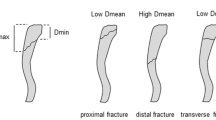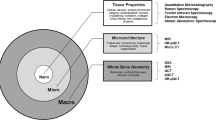Abstract
Summary
Young adults are at risk of stress fractures. Risk is higher in younger and female individuals. Stress fractures occur due to repeated loading of the bone (fatigue). We modeled this with rabbit tibiae. Age increased fatigue resistance which correlated with bone mineral density. A sex difference was not detected.
Introduction
Younger adults who engage in intense physical activity with a sudden increase in intensity level (military recruits/college athletes) are at risk of bone stress fractures. Risk is greater in females and diminishes with aging. Stress fractures may be the result of fatigue damage, which is not repaired rapidly enough to avoid fracture. It was hypothesized that the fatigue resistance of whole rabbit tibiae would be less in female specimens but greater as animal age increased.
Methods
Rabbit tibiae were harvested from three age groups (4, 7, and ≥12 months (females only)). The tibiae were scanned with dual energy X-ray absorptiometry to determine bone mineral density (BMD), computed tomography to quantify geometry, and then fatigue tested in three-point bending.
Results
In the ≥12-month group, BMD was approximately 20% higher, while the fatigue resistance was found to be approximately ten times higher than the other age groups. Sex was not a factor in the 4- and 7-month groups. Multiple linear regression revealed that fatigue life was negatively correlated with applied stress range and positively correlated with BMD (adjusted r 2 = 0.69).
Conclusions
A difference in fatigue behavior due to sex was not detected, but there was a large increase in fatigue resistance with age. This correlated with increased BMD and parallels a reduced risk of stress fracture due to age in military recruits. Skeletal “maturation” may play an important role in determining stress fracture risk. Increased risk in females may be due to mechanisms other than those that determine material behavior.





Similar content being viewed by others
References
Bennel K, Grimston S (2001) Risk factors for developing stress fractures. In: Burr DB, Milgrom C (eds) Musculoskeletal fatigue and stress fractures. CRC, Boca Raton, pp 15–33
Hulkko A, Orava S (2001) The roel of age in the development of stress and fatigue fractures. In: Burr DB, Milgrom C (eds) Musculoskeletal fatigue and stress fractures. CRC, Boca Raton, pp 55–71
Bennell KL, Brukner PD (1997) Epidemiology and site specificity of stress fractures. Clin Sports Med 16:179–196
Cooper C (1993) The epidemiology of fragility fractures: is there a role for bone quality? Calcif Tissue Int 53(Suppl 1):S23–S26
Jones BH, Harris JM, Vinh TN, Rubin C (1989) Exercise-induced stress fractures and stress reactions of bone: epidemiology, etiology, and classification. Exerc Sport Sci Rev 17:379–422
Jones BH, Bovee MW, Harris JM III, Cowan DN (1993) Intrinsic risk factors for exercise-related injuries among male and female army trainees. Am J Sports Med 21:705–710
Johnson KE (2004) Fracture among members of the active components. US Armed Forces Med Surveill Mon Rep 10:2–7
Milgrom C, Finestone A, Shlamkovitch N, Rand N, Lev B, Simkin A, Wiener M (1994) Youth is a risk factor for stress fracture. A study of 783 infantry recruits. J Bone Jt Surg Br 76:20–22
Swanson SA, Freeman MA, Day WH (1971) The fatigue properties of human cortical bone. Med Biol Eng 9:23–32
Burr DB, Turner CH (1999) Biomechanical Measurements in Age-Related Bone Loss. The Aging Skeleton, pp 301–311
Evans FG, Riolo ML (1970) Relations between the fatigue life and histology of adult human cortical bone. J Bone Jt Surg Am 52:1579–1586
O'Brien FJ, Taylor D, Clive LT (2005) The effect of bone microstructure on the initiation and growth of microcracks. J Orthop Res 23:475–480
Zioupos P, Gresle M, Winwood K (2008) Fatigue strength of human cortical bone: age, physical, and material heterogeneity effects. J Biomed Mater Res A 86:627–636
Carter DR, Hayes WC (1976) Fatigue life of compact bone–I. Effects of stress amplitude, temperature and density. J Biomech 9:27–34
Carter DR, Hayes WC, Schurman DJ (1976) Fatigue life of compact bone–II. Effects of microstructure and density. J Biomech 9:211–218
Norman TL, Nivargikar SV, Burr DB (1996) Resistance to crack growth in human cortical bone is greater in shear than in tension. J Biomech 29:1023–1031
Tommasini SM, Nasser P, Jepsen KJ (2007) Sexual dimorphism affects tibia size and shape but not tissue-level mechanical properties. Bone 40:498–505
Moreno LD, Waldman SD, Grynpas MD (2006) Sex differences in long bone fatigue using a rat model. J Orthop Res 24:1926–1932
Burr DB, Milgrom C, Boyd RD, Higgins WL, Robin G, Radin EL (1990) Experimental stress fractures of the tibia. Biological and mechanical aetiology in rabbits. J Bone Jt Surg Br 72:370–375
Li GP, Zhang SD, Chen G, Chen H, Wang AM (1985) Radiographic and histologic analyses of stress fracture in rabbit tibias. Am J Sports Med 13:285–294
Currey JD (1969) The mechanical consequences of variation in the mineral content of bone. J Biomech 2:1–11
Masoud I, Shapiro F, Kent R, Moses A (1986) A longitudinal study of the growth of the New Zealand white rabbit: cumulative and biweekly incremental growth rates for body length, body weight, femoral length, and tibial length. J Orthop Res 4:221–231
Masoud I, Shapiro F, Moses A (1986) Tibial epiphyseal development: a cross-sectional histologic and histomorphometric study in the New Zealand white rabbit. J Orthop Res 4:212–220
Turner CH, Burr DB (2009) Experimental Techniques for Bone Mechanics. In: Cowin SC (ed) Bone mechanics handbook, 2nd edn. CRC, Boca Raton, pp 1–35
Caler WE, Carter DR (1989) Bone creep-fatigue damage accumulation. J Biomech 22:625–635
Carter DR, Caler WE (1985) A cumulative damage model for bone fracture. J Orthop Res 3:84–90
Zioupos P, TW X, Currey JD (1996) The accumulation of fatigue microdamage in human cortical bone of two different ages in vitro. Clin Biomech (Bristol, Avon) 11:365–375
Schaffler MB, Choi K, Milgrom C (1995) Aging and matrix microdamage accumulation in human compact bone. Bone 17:521–525
Diab T, Condon KW, Burr DB, Vashishth D (2006) Age-related change in the damage morphology of human cortical bone and its role in bone fragility. Bone 38:427–431
Diab T, Sit S, Kim D, Rho J, Vashishth D (2005) Age-dependent fatigue behavior of human cortical bone. Eur J Morphol 42:53–59
O'Brien FJ, Taylor D, Lee TC (2003) Microcrack accumulation at different intervals during fatigue testing of compact bone. J Biomech 36:973–980
Carter DR, Caler WE (1983) Cycle-dependent and time-dependent bone fracture with repeated loading. J Biomech Eng 105:166–170
Hazenberg JG, Taylor D, Lee TC (2006) Dynamic short crack growth in cortical bone. Technol Health Care 14:393–402
Akkus O, Belaney RM (2005) Sterilization by gamma radiation impairs the tensile fatigue life of cortical bone by two orders of magnitude. J Orthop Res 23:1054–1058
Seeman E (2003) Periosteal bone formation—a neglected determinant of bone strength. N Engl J Med 349:320–323
LaMothe JM, Zernicke RF (2004) Rest insertion combined with high-frequency loading enhances osteogenesis. J Appl Physiol 96:1788–1793
Robling AG, Hinant FM, Burr DB, Turner CH (2002) Improved bone structure and strength after long-term mechanical loading is greatest if loading is separated into short bouts. J Bone Miner Res 17:1545–1554
Saxon LK, Robling AG, Alam I, Turner CH (2005) Mechanosensitivity of the rat skeleton decreases after a long period of loading, but is improved with time off. Bone 36:454–464
Srinivasan S, Weimer DA, Agans SC, Bain SD, Gross TS (2002) Low-magnitude mechanical loading becomes osteogenic when rest is inserted between each load cycle. J Bone Miner Res 17:1613–1620
Saxon LK, Turner CH (2005) Estrogen receptor beta: the antimechanostat? Bone 36:185–192
Saxon LK, Turner CH (2006) Low-dose estrogen treatment suppresses periosteal bone formation in response to mechanical loading. Bone 39:1261–1267
Saxon LK, Robling AG, Castillo AB, Mohan S, Turner CH (2007) The skeletal responsiveness to mechanical loading is enhanced in mice with a null mutation in estrogen receptor-beta. Am J Physiol Endocrinol Metab 293:E484–E491
Jarvinen TL, Kannus P, Pajamaki I, Vuohelainen T, Tuukkanen J, Jarvinen M, Sievanen H (2003) Estrogen deposits extra mineral into bones of female rats in puberty, but simultaneously seems to suppress the responsiveness of female skeleton to mechanical loading. Bone 32:642–651
Seeman E, Zebaze RM (2004) On Jarvinen et al. (Bone 2003;32(6):642-61). Bone 34:231–232
Friedman E, Vered I, Shemer J (2009) The genetic basis for stress fractures. In: Burr DB, Milgrom C (eds) Musculoskeletal fatigue and stress fractures. CRC, Boca Raton, pp 105–117
Acknowledgements
The authors wish to acknowledge the United States Army Medical Research and Materiel Command for funding. Thanks are also extended to Dr. Richard Renlund (University of Toronto), Dr. Larry White (Mount Sinai Hospital, Toronto) and Mr. Robert Parkes (Samuel Lunenfeld Research Institute) for their technical assistance.
Conflicts of interest
None.
Author information
Authors and Affiliations
Corresponding author
Rights and permissions
About this article
Cite this article
Willett, T.L., Wynnyckyj, C., Wang, J. et al. The fatigue resistance of rabbit tibiae varies with age from youth to middle age. Osteoporos Int 22, 1157–1165 (2011). https://doi.org/10.1007/s00198-010-1282-6
Received:
Accepted:
Published:
Issue Date:
DOI: https://doi.org/10.1007/s00198-010-1282-6




